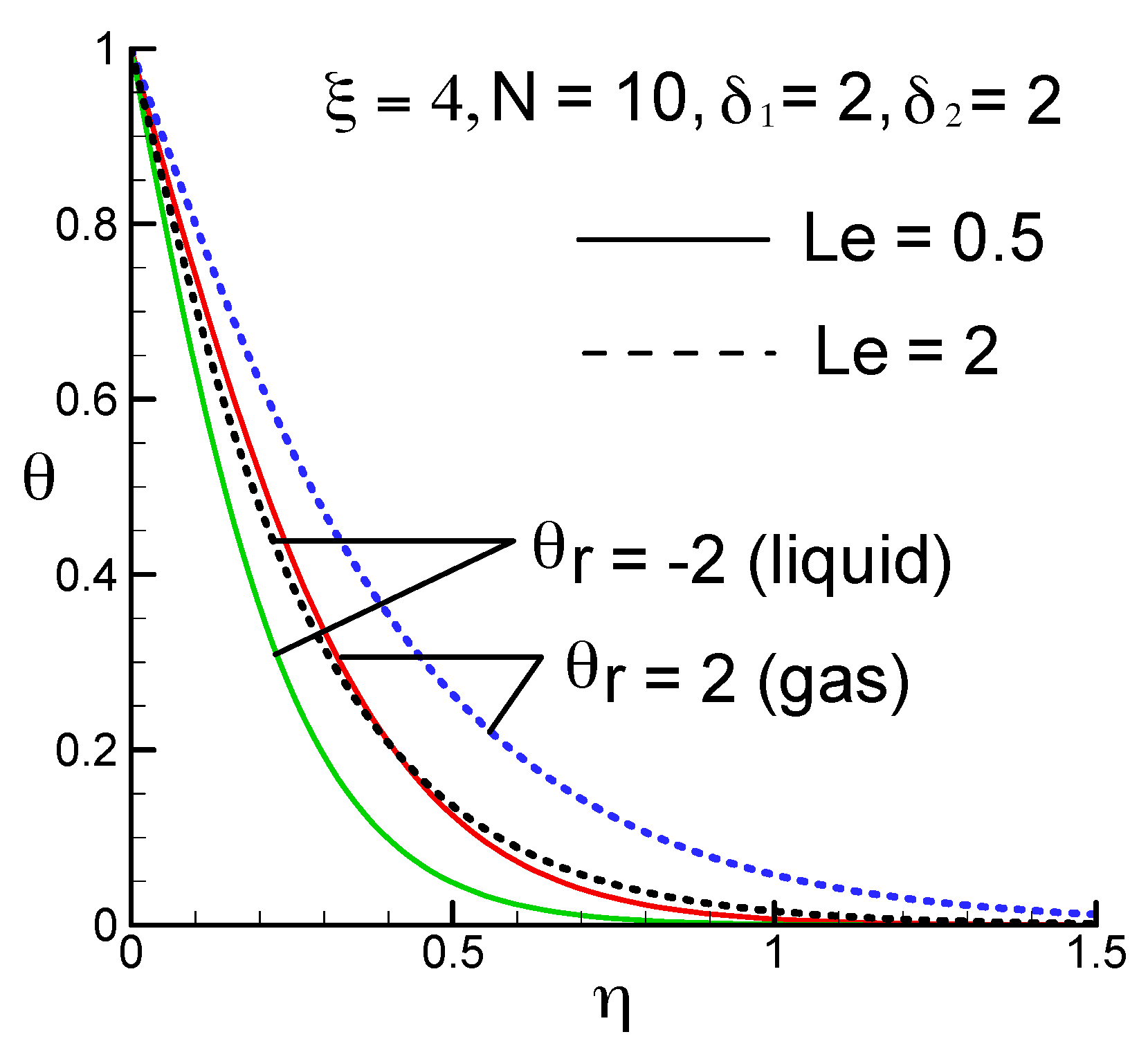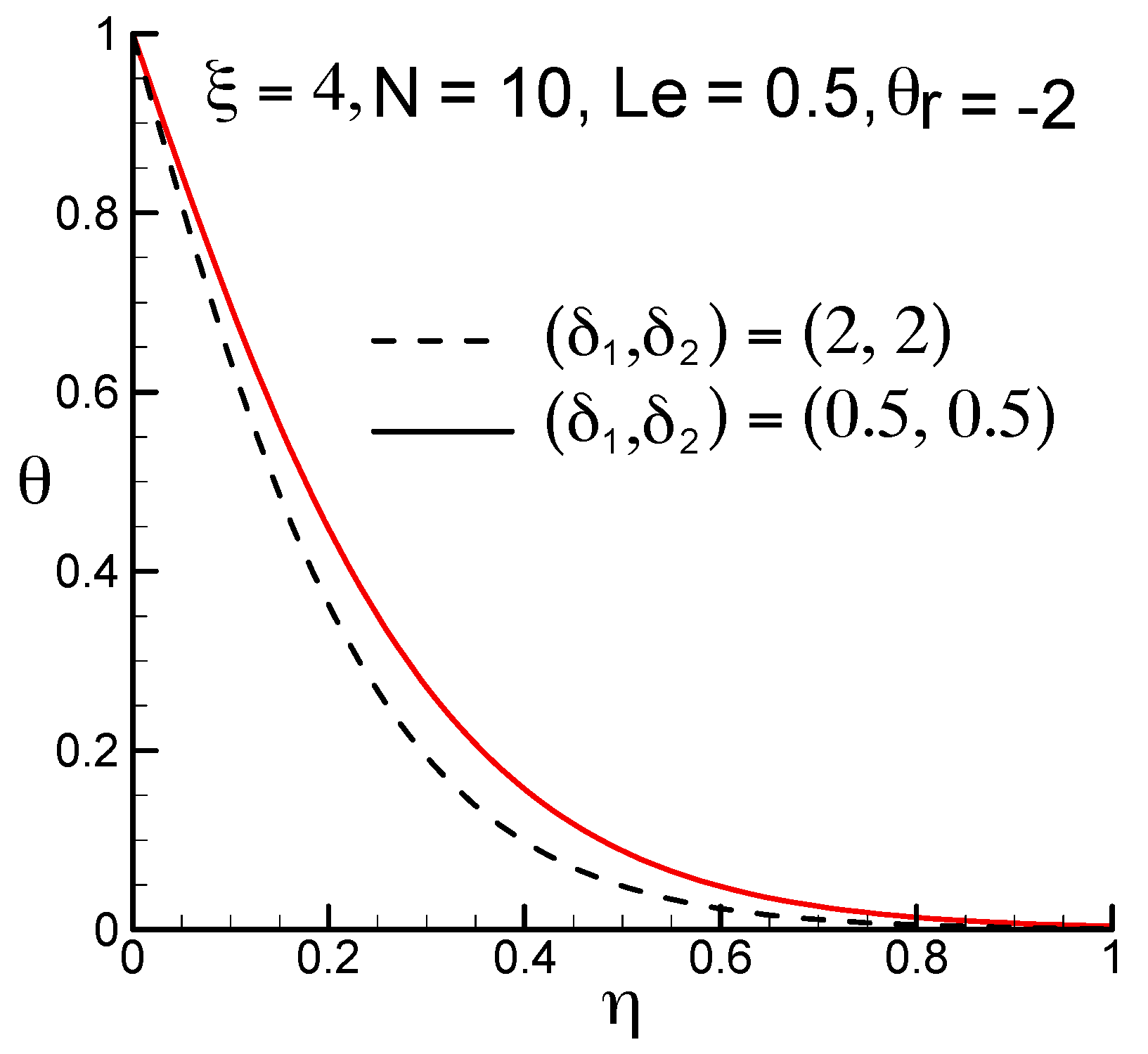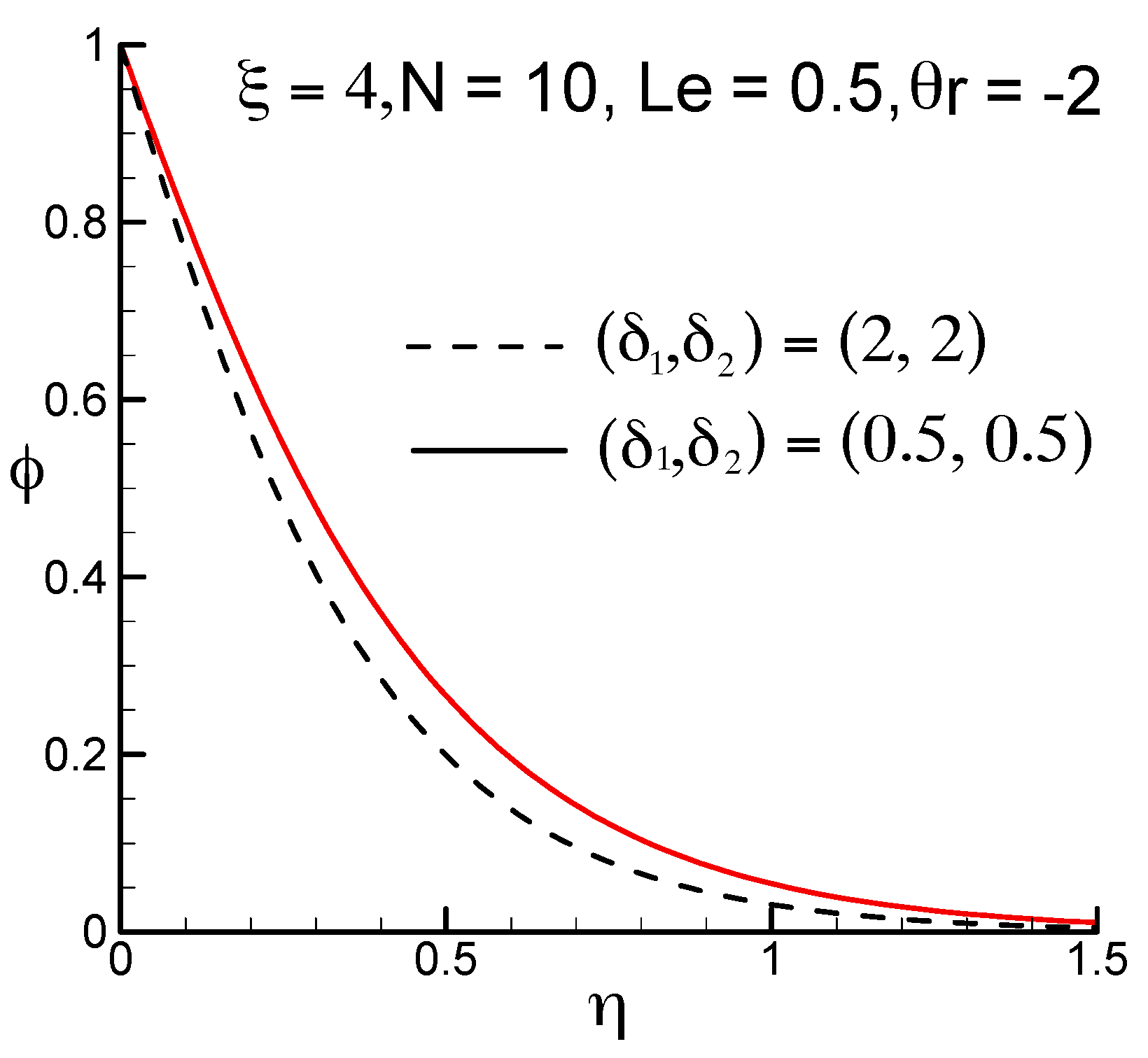1. Introduction
The coupled heat and mass transfer of free convection in saturated porous media have many important applications in nature and engineering. Examples include geothermal flow, nuclear waste storage, electronic heat transfer systems, building insulation, powder metallurgy, groundwater contamination, osmotic cooling and chemical industry separation procedures.
Cheng et al. [
1] analyzed natural convection of a Darcian fluid about a cone. With respect to the study on heat and mass transfer, the coupled heat and mass transfer by free convection over a truncated cone in porous media, variable wall temperature and variable wall concentration (VWT/VWC) or variable heat flux and variable mass flux (VHF/VMF) was solved by Yih [
2]. Cheng [
3] considered an integral approach for heat and mass transfer by natural convection from truncated cones in porous media with variable wall temperature and concentration. Cheng [
4] extended the work of Yih [
2] and Cheng [
3] to present Soret and Dufour effects on heat and mass transfer by natural convection from a vertical truncated cone in a fluid-saturated porous medium with variable wall temperature and concentration. Free convection from a truncated cone subject to constant wall heat flux in a micropolar fluid has been explored by Postelnicu [
5]. Chamkha [
6] considered coupled heat and mass transfer by MHD natural convection of micropolar fluid about a truncated cone in the presence of radiation and chemical reaction. Yih and Huang [
7] investigated the effect of internal heat generation on free convection flow of non-Newtonian fluids over a vertical truncated cone in porous media: VWT/VWC. Cheng [
8] solved free convection of a nanofluid about a vertical truncated cone. Amanulla et al. [
9] explored thermal and momentum slip effects on hydromagnetic convection flow of a Williamson fluid past a vertical truncated cone. Mahdy [
10] presented modeling of gyrotactic microorganisms non-Newtonian nanofluids due to free convection flow past a vertical porous truncated cone.
The study of the variable viscosity in porous media has been widely discussed. Lai and Kulacki [
11] considered the effect of variable viscosity on convective heat transfer along a vertical surface in a saturated porous medium. Mahdy et al. [
12] reported double-diffusive convection with variable viscosity from a vertical truncated cone in porous media in the presence of magnetic field and radiation effects. The effect of chemical reaction and heat generation or absorption on double-diffusive convection from a vertical truncated cone in porous media with variable viscosity was studied by Mahdy [
13]. Vajravelu et al. [
14] analyzed free convection boundary layer flow past a vertical surface in a porous medium with temperature-dependent properties.
The non-linear Boussinesq approximation has been the subject of much research. Vajravelu et al. [
14] obtained solutions for a class of coupled nonlinear differential equations, arising in free convection flow at a vertical flat plate embedded in a saturated porous medium at high Reynolds numbers in the presence of heat sources (or sinks) and with non-linear density temperature variation. Prasad et al. [
15] used the non-Darcy model and the non-Boussinesq approximation to explore free convection boundary layer flow past a vertical surface in a porous medium with temperature-dependent properties. With respect to heat and mass transfer, Kameswaran [
16] examined the thermophoretic and non-linear convection in non-Darcy porous medium. Combined convection from a wavy surface embedded in a thermally stratified nanofluid saturated porous medium with non-linear Boussinesq approximation was analyzed by Kameswaran et al. [
17]. The non-linear Boussinesq article for the case of truncated cone is lacking.
However, there are still very few instances of the Taguchi method being used to find the maximum values by simulation. Ho et al. [
18] suggested adaptive network-based fuzzy inference system for prediction of surface roughness in the end milling process using hybrid Taguchi-genetic learning algorithm. Chou [
19] studied optimization methods and examples. Taguchi optimization of bismuth-telluride-based thermoelectric cooler was examined by Kishore et al. [
20]. Li and Kao [
21] found Taguchi optimization of solar thermal and heat pump combi-systems under five distinct climatic conditions.
In this exploration, the Taguchi method and the numerical simulation of variable viscosity and non-linear Boussinesq effects on natural convection over a vertical truncated cone in porous media are investigated. To the best of our knowledge, this problem has not been investigated before. The partial differential equations are transformed into non-similar equations and solved using the Keller box method (KBM) proposed by Cebeci and Bradshaw [
22]. The numerical simulation of six different parameters is carried out to obtain the maximum value of the local Nusselt (Sherwood) number and find the best parameter ratio. The study is divided into two phases: the first phase of the data is compared with the previously published article, the results are considered very consistent. The main parameters on the local Nusselt (Sherwood) number are presented in graphic and tabular form. The second stage uses the Taguchi method to optimize the six parameters of the local Nusselt (Sherwood) number. The larger the local Nusselt (Sherwood) number, the greater the amount of heat (mass) that is taken away from the cone.
3. Results and Discussion
To verify the accuracy of our current method, we compared our results with those of Cheng [
1], Yih [
2] and Yih and Huang [
7]. The results were very consistent, as shown in
Table 3.
The numerical results are presented for the dimensionless streamwise coordinate ξ ranging from 0 to 4, the buoyancy ratio N ranging from 1 to 10, the Lewis number Le ranging from 0.5 to 2, the viscosity-variation parameter ranging from −2 to 2, the non-linear temperature parameter ranging from 0.5 to 2, the non-linear concentration parameter ranging from 0.5 to 2.
Figure 1 and
Figure 2 plot the effects of Lewis number Le and the viscosity-variation parameter
on the dimensionless temperature profile and the dimensionless concentration profile with ξ = 4, N = 10,
= 2,
= 2, respectively. On the one hand, for the case of
> 0 (gas), for a fixed Le, it is observed that both the dimensionless temperature profile and the dimensionless concentration profile increase, thus decreasing the dimensionless wall temperature gradient as well as the dimensionless wall concentration gradient. This is due to the fact that for the case of
> 0, the flow velocity tends to decrease with the assistance of Equations (16) and (21). Therefore, the dimensionless wall temperature and concentration gradients are reduced. On the other hand, for the case of
< 0 (liquid), at a given Le, not only the dimensionless temperature profile, but also the dimensionless concentration profile is decreased. Therefore, both the dimensionless wall temperature and concentration gradients have the tendency to increase.
In
Figure 2, for
= −2 and Le = 0.5, it is observed that the dimensionless wall temperature gradient is large. However, in
Figure 3, for
= −2 and Le = 2, it was found that the dimensionless wall concentration gradient is large. From Equation (23), Le = α/D, we can find that the increase in the Le leads to an increase in the thermal boundary layer thickness
and a decrease in the concentration boundary layer thickness
.
Figure 4 and
Figure 5 show the effects of the non-linear temperature parameter
and the non-linear concentration parameter
on the dimensionless temperature profile and the dimensionless concentration profile with ξ = 4, N = 10, Le = 0.5,
= −2, respectively. In
Figure 4 and
Figure 5, for
= 2 and
= 2, it is observed that the dimensionless wall temperature gradient and the dimensionless wall concentration gradient are large. From Equation (16), as
and
become larger, the flow velocity becomes larger, and thus both the dimensionless wall temperature and concentration gradients increase.
The orthogonal table values of the local Nusselt number, the local Sherwood number, the local Nusselt number signal/noise ratio and the local Sherwood number signal/noise ratio are shown in
Table 4. Using the values of the orthogonal table and the Taguchi analysis, we can obtain the Nusselt (Sherwood) number signal/noise ratio and mean value, as illustrated in
Table 5 (
Table 6). From the local Nusselt number and the signal/noise ratio, data can be obtained from the A factor is the level 3, B factor is the level 3, C factor is the level 1, D factor is the level 1, E factor is the level 2 or 3, and F factor is the level 3. From the local Sherwood number and the signal/noise ratio, data can be obtained from the A factor is the level 3, B factor is the level 3, C factor is the level 3, D factor is the level 1, E factor is the level 3, and the F factor is the level 3.
The results obtained using the Taguchi method are superior to the original combination of parameter settings. Using ξ (4), N (10), Le (0.5), (−2), (1 or 2), (2) in comparison with the highest value in the orthogonal table ξ (4), N (10), Le (0.5), (−2), (1), (1), the results show for the case of ξ (4), N (10), Le (0.5), (−2), (1), (2) and ξ (4), N (10), Le (0.5), (−2), (2), (2), that the local Nusselt numbers are 3.8318 and 3.8636, respectively. For ξ (4), N (10), Le (0.5), (−2), (1), (1), the local Nusselt number is 3.4053. Using ξ (4), N (10), Le (2), (−2), (2), (2) in comparison with the highest value in the orthogonal table ξ (4), N (10), Le (2), (2), (2), (2), the results show that the local Sherwood number is 5.1156 for the case of ξ (4), N (10), Le (2), (−2), (2), (2). For ξ (4), N (10), Le (2), (2), (2), (2), the local Sherwood number is 3.2799. It is known from the above verification by the Taguchi method that, for the cases of ξ (4), N (10), Le (0.5), (−2), (2), (2) and ξ (4), N (10), Le (2), (−2), (2), (2), the best data are obtained.
Table 7 lists the values of the local Nusselt number and the local Sherwood number for various values of
, Le,
,
, N, ξ. As the
increases from −2 to 2, the local Nusselt number and the local Sherwood number decrease. This is because for the case of
> 0 (gas), both the dimensionless surface temperature and concentration gradients decrease, as shown in
Figure 2 and
Figure 3. As the Lewis number Le increases from 0.5 to 2, the local Nusselt number decreases. This is due to the fact that a larger Lewis number Le is associated with a thicker thermal boundary layer thickness, as shown in
Figure 2. The thicker the thermal boundary layer thickness, the smaller the local Nusselt number. However, the concentration boundary layer thickness becomes thin, as shown in
Figure 3. The thinner the concentration boundary layer thickness, the greater the local Sherwood number. With an increase in the non-linear temperature parameter
and the non-linear concentration parameter
from 0.5 to 2, the local Nusselt number and the local Sherwood number increase. That is because when increasing the non-linear temperature and concentration parameters, both the dimensionless wall temperature and concentration gradients increase, as shown in
Figure 4 and
Figure 5. With the help of Equations (26) to (27), the greater the dimensionless wall temperature (concentration) gradient, the greater the local Nusselt (Sherwood) number. Generally speaking, both the local Nusselt number and the local Sherwood number increase when the buoyancy ratio N increases from 1 to 10. This is due to the fact that the increase in the value of N tends to increase the buoyancy force, accelerating the flow and thereby the thermal boundary layer thickness and concentration boundary layer thickness become thin. Increasing the value of the dimensionless streamwise coordinate ξ enhances the local Nusselt number as well as the local Sherwood number. This is because the increase in the value of ξ decreases both the thermal boundary layer thickness and the concentration boundary layer thickness.










